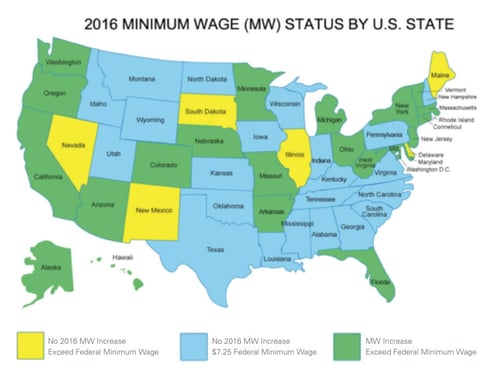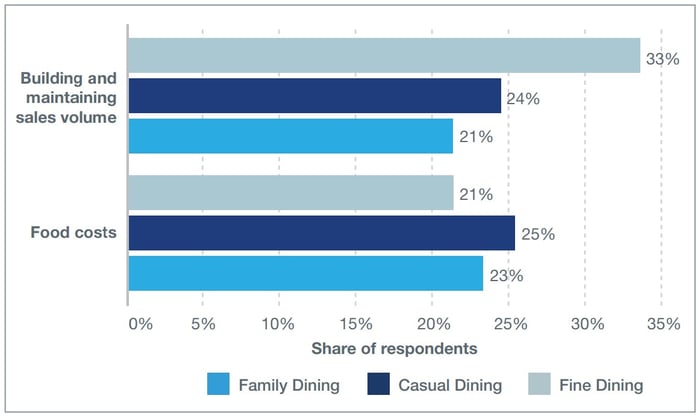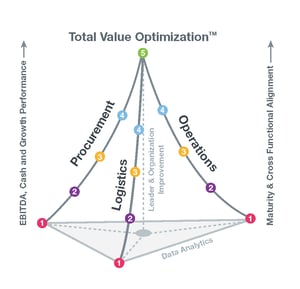Achieving operational excellence inside your multi-unit restaurants
This perspectives paper outlines 3 key drivers that are causing margin erosion for both restaurant holding companies and restaurant brand owners. It considers the implications of not addressing the threat these pose to your business and outlines the operational improvement areas that will drive restaurant margin improvement (RMI).
Few people in the restaurant market would disagree that they are in a battle to protect and grow their margins. Restaurants need to re-evaluate the way they control labor, food and third party costs and optimize their buy-make-move-fulfill supply chain. Those who do this successfully will survive, thrive and tap into significant EBITDA opportunities.
Three key drivers that are causing margin erosion
1. Increase in the Federal minimum wage
As of January 1 2016, laws raising the Federal minimum wage came into effect in 12 states. The increases range from as little as $0.15 cents (Arizona, Missouri, Montana and Ohio) to as much as $1.00 (Alaska, California, District of Columbia, Massachusetts and Nebraska). This means that hourly rates will range from $7.25 and hour to $11.50 for the District of Columbia. In addition Los Angeles, San Francisco, the District of Columbia, Washington and Seattle have legislation in place which will take the minimum wage to $15 by 2020. In March 2016, California joined them by agreeing to raise its minimum wage to $15 by 2022.
For employers everywhere, the impact is significant but nowhere more so than in the restaurant sector where labor costs will increase from 2.5% to 3.5% of sales revenue.

Figure 1: National Conference of State Legislature Minimum Wage Map
2. Intensified demand for consistent delivery of your brand promise (Guest Experience)
Customers are (quite rightly) becoming more demanding, and consistent Quality, Service, Cleanliness (QSC) is the way to win their loyalty. Restaurants must deliver QSC to drive same- store sales increases and obtain profitable growth at each unit. Quality is not simply taste and appearance any longer; it includes supply chain transparency and food safety. This is evidenced by an Empathica Benchmark Survey that shows the likelihood of a return visit increases from 20% to 81% when customers report a higher satisfaction rate. Conversely, poor QSC will drive them to your competitors.
3. Poor management and control can lead to increasing repair and maintenance (R&M) costs
The cost of R&M is the third driver that is impacting retail margins. This encompasses land lease/purchase costs, facilities, unit insurance, maintenance and repair costs. A 2015 Statista Survey identified R&M costs as the number one challenge faced by full service restaurant operators in the United States in 2015.
 Source: Statista 2016: Challenges by full-service restaurant operators in the United States in 2015, by restaurant type.
Source: Statista 2016: Challenges by full-service restaurant operators in the United States in 2015, by restaurant type.
Three Key operational improvement areas that will drive Restaurant Margin Improvement (RMI)
1. Controlling labor costs
Having the right people, properly trained, with proper utilization will provide the Guest Experience your brand promises, which is critical to protecting/ growing same-store margins. This means you need to:
- Consistently deploy proper on-boarding, skills training, culture/ brand promise education and operating compliance
- Further develop the art and science of labor scheduling to optimize the Guest Experience
- Optimize the guest/investment ROI
- Maximize Limited Time Offers (LTOs) that affect the art/ science of labor planning, food cost/ portion control and Guest Experience
- Continually maintain insight into the types of unique Guests
2. Food Cost inside the unit
Optimizing and managing portion control inside the unit is the second area that has a significant impact on RMI. The question here is how consistent is portion control and food waste with your brand promise, quality and engineered profitability targets? To answer this you need to evaluate the consistency of portions to meet your promise every time whilst taking total control of costs.
3. Controlling R&M costs
Finally, controlling the cost of Repair and Maintenance is critical to protecting margins. This involves:
- Reviewing all 3rd party suppliers and your brand’s corporate services
- Proper training and utilization of 3rd parties in and around the unit
Achieving Operational Excellence
Total Value OptimizationTM (TVO) is a way to achieving RMI and operational excellence in your multi-unit restaurant.
Maine Pointe illustrates Total Value Optimization (TVO) using the TVO Pyramid™. The graphic is a conceptual representation of the critical interdependencies across the parallel, and too often siloed, supply chain functions of strategic procurement, distribution, and retail operations which collectively comprise the buy-make-move-fulfill supply chain.
TVO is achieved when an organization is dynamically able to anticipate and meet demand through the synchronization of its buy-make-move-fulfill supply chain to deliver the greatest value to customers and investors at the lowest cost to business.”
